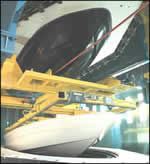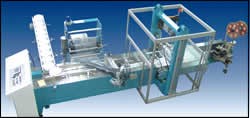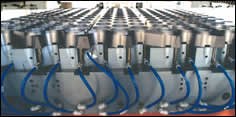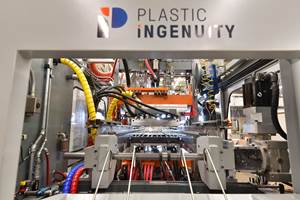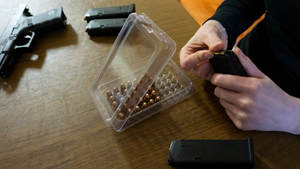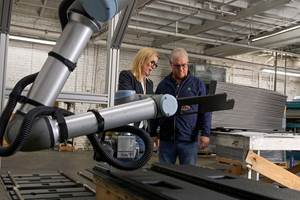NPE News Wrap-Up: Thermoforming
Soaring interest in in-mold finishing techniques for injection molding and fiber-reinforced composites offers new prospects for cut-sheet formers.
Thermoformers might be surprised to learn that some of their most promising new opportunities are in injection molding and thermoset composites. Injection molders of everything from cell-phone housings to auto fascias are turning to in-mold finishing with thermoformed film inserts to avoid the mess and expense of painting. Likewise, some molders of composites for boats and other products are looking to save time and environmental-compliance costs with thermoformed skins as a replacement for gel coats. Some observers speculate that growth of in-mold finishing could drive cut-sheet forming to new levels of sophistication in part quality and productivity.
Meanwhile, the attention-getter in thermoformed packaging at the show was new roll-fed equipment claimed to set benchmarks for throughput of disposable PP, PS, and PET food trays, containers, and lids. These machines put out 60,000 single-serve containers an hour or 350,000 portion cups and lids.
In-mold finishing beckons
Paul Alongi, president of Maac Machinery, argues that injection molders’ growing interest in film insert molding (FIM) is critical to the future of cut-sheet forming. FIM involves volumes of 1 million units or more in high-visibility markets like automotive and consumer electronics. He says three- and four-station rotary machines are strong candidates for this business sector, which has kept Maac quite busy in recent months. “Both custom and automotive Tier One formers are bracing to meet the demanding requirements of the appliqué market,” says Alongi. He adds that rotary formers work well with PP and TPO, the favored materials for FIM.
Wolfgang Daum, FIM specialist at Germany’s Geiss AG, argues that his company’s T8 single-station former with flash halogen heaters is also well suited to FIM. Daum claims it is especially good for the new downgauged appliqués that are only 0.8 to 1.3 mm thick.
Daum says halogen heating penetrates to the sheet core, creating “inside-out” heat. As a result, cross-sectional heating of the sheet is highly uniform, minimizing internal stresses. Halogen heating also is said to be faster, giving the single-station T8 output equal to a three-station rotary.
Moreover, appliqué forming in the T8 is done in a closed chamber that Daum says ensures excellent control of sheet sag and temperature, which improves part quality. Geiss has already sold three T8 systems for FIM use—to Thule USA, Seymour, Conn., a maker of roof racks for cars; GE Plastics, Pittsfield, Mass., for FIM prototyping; and Profile Plastics, Lake Bluff, Ill., for custom forming.
Meanwhile, materials introduced at the show further stimulated interest in decorative formed panels. GE Plastics introduced Geloy XTW, a new version of its weatherable ASA that offers three- to five-fold improved color and gloss retention. It is a candidate for FIM appliqués and large formed parts for spas, tractors, watercraft, and outdoor vehicles. BASF also launched a high-performance version of its Luran S ASA that can be used in appliqués and exterior panels.
DuPont launched Delrin Forming Solutions (DFS)—acetals with sufficient melt strength for thermoforming. DFS grades offer an array of potential colors and special effects (e.g., metallic). They can be decorated by in-mold coating, foil stamping, and painting. Freetech Plastics in Fremont, Calif., is forming DFS into medical and dental equipment.
Giving boats a new shine
Another promising opportunity for industrial thermoformers is replacing gel coats in large fiberglass/polyester composites produced by the RTM closed-mold process. According to sources at Minneapolis boat builder Genmar Holdings, composite back-up of thermoformed skins has been successful with open-mold spray-up but not with closed-mold processes—until now. Genmar claims to have overcome previous hurdles with its VEC Shield closed-mold RTM process. Irwin Jacobs, Genmar’s CEO, says VEC Shield has potential in boat hulls, recreational vehicles, and sanitary ware.
VEC Shield was used to make the hull of a Genmar’s 2004 model Four Winns fiberglass pleasure boat exhibited at NPE by GE Plastics, which supplies the resins for the coextruded weatherable sheet used in the hull. The acrylic/ASA/ABS sheet is extruded by Spartech and can incorporate colors and metallic or sparkle effects.
Closed-mold processing produces a boat hull in 1 hr instead of 8 hr or more with open-mold laminating. Elimination of the gel coat means that virtually no styrene is emitted into the workplace or atmosphere. Also, gel coats are said to be much more susceptible to cracking and other surface imperfections. The gauge uniformity of VEC Shield makes hulls lighter than before.
Genmar plans to convert all its boats less than 24 ft long to VEC Shield over the next two years. A manufacturing cell is being built at the Four Winns plant in Cadillac, Mich. Forming of the skins is done by Kinro Composites, a Genmar subsidiary in Waxahachie, Texas.
Packaging outputs rising
At NPE, the focus in roll-fed, in-line forming was primarily on boosting output of disposable packaging with the latest servo motors. For example, Zed Industries exhibited a 30 x 38 in. version of its new high-output SF (Servo-Former) series. These models have four-post forming and punch presses. A novel cam mechanism substitutes for toggles to give smoother motion to the top and bottom platens. Servo-driven roller-pin chains are used to index rollstock with precise registration. At the show, HIPS lids ran at 55 cycles/min, or 150,000 parts/hr.
OMV-USA unveiled the F57 system for high-volume in-line extrusion, forming, rim-rolling, stacking, and counting. Platens utilize four-post guides, while a new toggle mechanism is said to provide vibration-free operation at high speed. Plug assist is also servo driven.
The OMV F57 CST with platens up to 60 x 57 in. and separate trim press is aimed at PS, PET, and APET. A unit with a 180-cavity tool was shown making 7-oz cups at 345,000 parts/hr. The OMV FT57 CMT has a built-in trim press and is designed for PP containers with up to 9-in. draw. A 42 x 38 in. unit runs 42-oz containers at 60,000/hr.
Irwin Research discussed a new machine set-up for high output of foamed PS plates. It combines the company’s Model 50 former and Model 50 NT vertical trim press with a servo-driven ejector and the brand-new servo-driven 22-7 Stack Packer. A 25-cavity tool makes 54,000 parts/hr.
Brown Machine upgraded its auxiliaries to im prove productivity. Its A190 four-way adjustable clamp frame for cut-sheet formers is said to be “the most versatile and easily changeable clamp frame on the market.” Wide-mouth design facilitates sheet positioning and reduces scrap. Quick-release pins and quick disconnects permit frame changes without tools.
For roll-fed equipment, Brown launched the Servo Flex, a servo-driven “pusher system” with grab-and-release fingers for moving the sheet.
Related Content
Ingenuity Is Part of This Former’s Name, and in Its DNA
Plastic Ingenuity started in a garage in 1972 and through a commitment to developing best-in-class products stands today as one of the largest custom thermoformers in the world.
Read MoreNovel ‘Clamtainer’ Extends Thermoformer's Reach in Packaging
Uniquely secure latching expands applications for Jamestown Plastics’ patented clamshell package design.
Read MoreExxonMobil Develops High-Performance, 95% PE Recyclable Thermoformed Packaging
The packaging solution involved a collaboration with equipment suppliers Hosokawa Alpine and Multivac Group.
Read MoreCobot Creates 'Cell Manufacturing Dream' for Thermoformer
Kal Plastics deploys Universal Robot trimming cobot for a fraction of the cost and lead time of a CNC machine, cuts trimming time nearly in half and reduces late shipments to under 1% — all while improving employee safety and growth opportunities.
Read MoreRead Next
For PLASTICS' CEO Seaholm, NPE to Shine Light on Sustainability Successes
With advocacy, communication and sustainability as three main pillars, Seaholm leads a trade association to NPE that ‘is more active today than we have ever been.’
Read MoreSee Recyclers Close the Loop on Trade Show Production Scrap at NPE2024
A collaboration between show organizer PLASTICS, recycler CPR and size reduction experts WEIMA and Conair recovered and recycled all production scrap at NPE2024.
Read More


